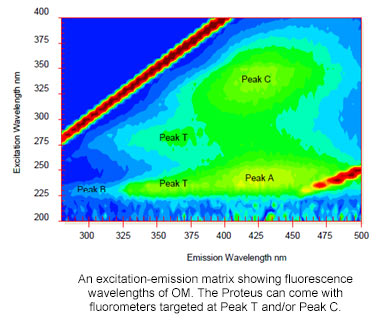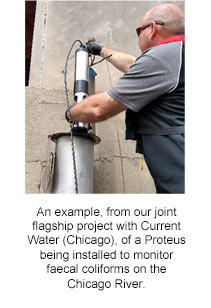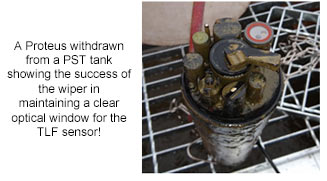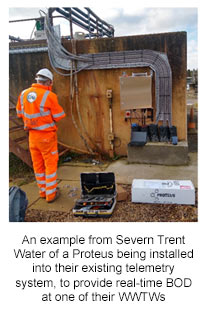Technical Note: A comparison of Proteus fluorescence spectroscopy with UV-Vis technology
Principles of Fluorescence Spectroscopy

Fluorescence spectroscopy techniques have been gaining in popularity since the late 1990s and originate based on the intrinsic fluorescent properties of different groups of organic matter (OM); that is, organic matter that fluoresces naturally. Over time, groups of organic matter have been associated with different fluorescence excitation and emission wavelengths. When an OM particle is excited with UV light, the electrons are elevated to higher energy levels surrounding the atom. When the excitation ends, the electrons can return to their original energy level or 'ground-state'- via a number of pathways, some of which are radiative (involving the release of light). For example, tryptophan-like fluorescence is known to emit 350-360nm when excited 230nm(280nm). Based on this knowledge, laboratory desk-top spectrophotometers were used to scan extensive ranges of wavelengths to analyse liquids and identify their OM content.
In the last decade, technology has been developed to take techniques that were previously only achievable in a laboratory setting and integrating them into a standalone sensor, whereby particular wavelengths can be targeted; from this came the patented Proteus. The Proteus utilises UV sensors which target specific known wavelengths (TLF and Peak C/fulvic-like fluorescence) and then combines the reading with an algorithm and other sensor outputs to translate to BOD as well as other parameters such as Total Coliforms (TC). The exact sensor set-up is related to the client's individual requirements but the number of UV fluorometers required is flexible.
Principles of Ultra-Violet/Visible Spectrophotometry
The only similarity of UV-Vis (sometimes referred to as UV 254) to fluorescence spectroscopy is that it utilizes wavelengths on the UV portion of the EM spectrum. The approach is different and the results, when applied to BOD, are vastly different. The principles of UV-Vis surround absorbance of UV light on a wavelength 200-750nm, where the absorption of light is related to the chemical structure of the compound of interest; the absorption is then related to the concentration of substances in-line with the Beer-Lambert law.
UV-Vis is generally considered as a 'first pass' for investigating water quality, as it is a nonspecific measure that is unsuitable if the target chemical compounds are unknown e.g. with UV 254 as not all organic compounds absorb at 254nm. Generally, the UV wavelengths scanned are a much broader spectrum and are unable to target specific wavelengths unlike fluorescence spectroscopy methods.
Why Proteus over UV-Vis? - A Summary
| Parameter | Proteus | UV-Vis |
| Specific Wavelength targeting? | Yes | No |
| High Sensitivity with single molecule detection possible? | Yes | No |
| Discrimination between organic matter that absorbs on similar wavelengths? | Yes | No |
| Complex considerations for the environment e.g. path length? | No | Yes |
| In-built temperature correction? | Yes | No |
| In-built sensor health check? | Yes | No |
| Real-time? | Yes | No |
| Complicated mounting and install requirements? | No | Yes |
| High ongoing maintenance costs? | No | Yes |
| Integrated self-cleaning as standard? | Yes | No |
| Includes non-fluorescence/UV sensors for more detailed water quality analysis? | Yes | No |
| Long-life LEDS used as standard? | Yes | Not all models |
| Internal battery option that supports flexible logging? | Yes | No |
Why Proteus over UV-Vis? - Extended Detail
- The Proteus targets specific wavelengths depending on the parameter required, BOD for example, that are associated with different types of organic matter. The raw reading is then integrated into a robust algorithm consisting of related parameters and site-specific calibration coefficients. The theory underpinning the algorithm and calibrations is the product of extensive, peer-reviewed research as an outcome of the KTP with the University of Birmingham.
- The patented Proteus methodology is causing a paradigm shift in the way water quality is monitored worldwide as the previously impossible has been made possible. While UV-Vis has been used in research, generally standard set-ups are utilised with regard to wavelength detection, path length etc., and the technology is not as specific and targeted as a Proteus set-up.
- On average, fluorescence spectroscopy technology is 10-1000x more sensitive than UV-Vis and has the potential to discriminate between different types of fluorescent DOM as while they absorb on similar wavelengths, they do not fluoresce on the same wavelengths.
- Due to the nature of the UV fluorometers, path length is not an applicable consideration making the Proteus suitable in most environments with its standard set-up. UV-Vis often requires changing path lengths to ensure the data doesn't suffer deviations from Beer-Lamberts law but the Proteus performs well across the whole range of TLF/Peak C concentrations.
- The Proteus also has automatic temperature compensation to avoid thermal quenching of the signal which can cause erroneous and imprecise data to be reported.
- During both in-house and field calibration, all our sensors report a Sensor Response Factor (SRF) which informs on the health and functioning on each individual sensor, an extra verification that each sensor is performing optimally.
- The Proteus enables real-time data straight from the point of deployment owing to our robust factory calibrations which are then fine-tuned using site-specific calibrations.
- There is no need to purchase a 'mounting kit' or other installation equipment - the Proteus deployment can be as easy as suspension from a rope or as simple as you require it; in many cases the Proteus has been successfully fitted into existing infrastructure without modification.
- UV-Vis instruments will typically only have UV sensors on them providing only a few parameters which are all related which can leave the instrument vulnerable to single-point failures. This means it can be difficult to identify erroneous readings as all the readings are related (i.e. whether there is a sensor malfunction or whether something in the environment has changed in an unexpected way). The Proteus can house up to 12 sensors and from that over 30 parameters can be monitored – UV-Vis technology generally has up to 4 sensors which reports up to 7 parameters. In addition, the extra sensors mounted on the Proteus can provide complementary information on a range of variables while simplifying existing sampling procedures. All parameters are being monitored at exactly the same point and therefore are able to provide a complete picture of water quality.
- The Proteus range of custom parameters is also ground-breaking, and BOD is an example of this. Any parameter the customer requires, which can be measured by a combination of the sensors on offer, we can write the algorithm and calibration; for example, BOD and TSS. All we require from the customer is what they would like to use to calculate it, if we do not have previous experience with it.
- In this sense, the Proteus is also future-proofed as new sensors can easily be retrofitted for additional parameters and sensor replacement when they eventually reach the end of their operational life.
- There are no hidden maintenance costs as each Proteus with UV sensors comes with an integrated wiper brush which have proven extremely effective in heavy-fouling environments. In fact, Proteus units are regularly deployed on the inlets to wastewater treatment works! The wipers are low-cost and generally should be replaced annually, although it can be less frequently depending on the level of soiling/environment in which the Proteus is deployed. This means there are no hidden costs unlike sensors which use compressed air mechanisms as they require extra set-ups, mechanisms and power consumption.
- All Proteus models use LEDs unlike UV-Vis technology where the Xenon bulb is still overwhelmingly used. Xenon bulbs are expensive and have a short operational life as well as being notoriously fragile compared with robust LEDs which have an operating life of 10,000+ hours - There is no return-to-base element with LED replacement, unlike Xenon, they can be replaced at the end of their operational life in the field by clients or by Proteus engineers, depending on preference.
- The Proteus is designed for easy, full integration with either new or existing telemetry systems HMI via RS232/Modbus/SDI12 - no need to purchase a new system and integration means data supplied can be used for control over other functions e.g. dosing control in a wastewater treatment plant – The latest version of Proteus will have MODBUS built-in as standard.
- The Proteus also comes with an internal battery option which allows for totally flexible integration and use, something that UV-Vis based instruments do not offer.



